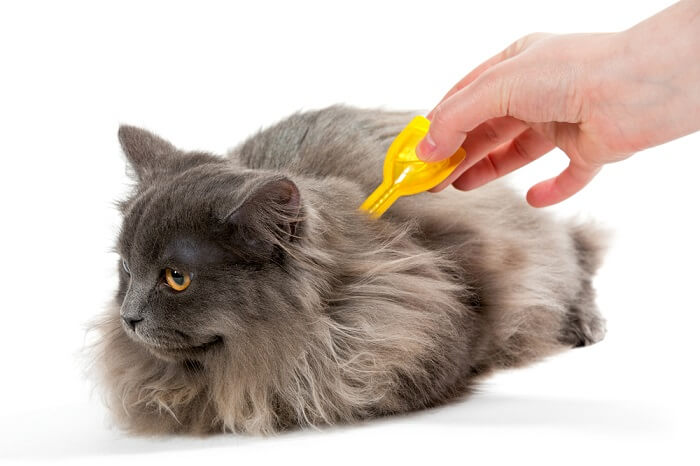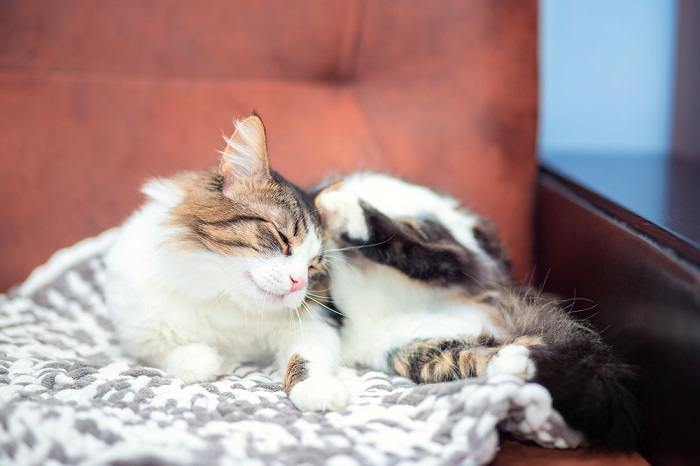 Frontline is a brand of topical, “spot-on” flea/tick treatment and prevention containing the ingredient fipronil. The patent on fipronil expired in 2010, leading to the release of many generic products. Frontline has since become only available as the products Frontline Plus and more recently, Frontline GOLD.
Frontline is a brand of topical, “spot-on” flea/tick treatment and prevention containing the ingredient fipronil. The patent on fipronil expired in 2010, leading to the release of many generic products. Frontline has since become only available as the products Frontline Plus and more recently, Frontline GOLD.
Frontline Plus for Cats Overview

In this article, you’ll learn specifically about the Frontline Plus product for cats, the ingredients it contains, what types of parasitic pests it targets, possible side effects to consider, and some frequently asked questions.
If you’re looking for a broader article on all Frontline products, see our article Frontline for Cats.
About Frontline Plus for Cats

Fipronil is the primary active ingredient in all Frontline products for both dogs and cats. It is indicated for treating fleas, ticks, and chewing lice. It can also kill mosquitoes. While not labeled for it, it has also been successful in treating for chiggers and the sarcoptic mange mite.
Fipronil is a phenylpyrazole antiparasitic agent, and is technically classified as a pesticide. In invertebrates (including insects like fleas and arachnids like ticks and mites), it interrupts GABA-regulated nerve channels, causing neurologic overexcitement, disruption and death.
Frontline “spot-on” flea and tick treatment products are applied to the surface of a small target area or “spot” of the skin, usually at the back of the head or neck.
Fipronil collects in the oils of the skin and hair, allowing for continual release, lending to its 30 day period of efficacy for flea and tick protection. Per the product label, it takes about 24 hours to spread throughout surface oils on skin and hair to provide complete protection.
It is important to note that while these pesky pests are affected by Frontline by coming in contact with the skin and don’t have to actually bite a kitty to die, Frontline products do not provide true repellency that would prevent fleas or ticks from coming in contact with a pet.
What Does Frontline Plus Do for Cats?

Frontline products are among the only topical “spot-on” options for cats providing protection against both fleas and ticks. Other products for cats may only protect against fleas and some ticks, or just fleas.
Frontline Plus specifically includes the addition of (S)-methoprene, which is an insect growth regulator that additionally controls the flea life cycle by targeting flea eggs and flea larvae, helping to interrupt the life cycle and prevent new adults from hatching and developing.
Side Effects of Frontline Plus for Cats

Most flea-infested cats develop dermatitis, with hair loss and itchy skin especially over the lower back, around the head, and elsewhere.
When used properly, side effects to Frontline products are uncommon. Frontline Plus for cats is only labeled for cats older than 8 weeks of age. Topical products like Frontline should never be ingested.
The most commonly reported effect is a temporary irritation at the application site. More red, irritated skin has been reported, but is considered rare. If this occurs, it is more likely a kitty has a hypersensitivity or allergy to one of the ingredients.
If this occurs, the manufacturer recommends bathing with a mild soap (Dawn dish soap for example) and rinsing with lots of water. Veterinary care should be sought with any persisting or worsening signs of skin irritation.
Both ingredients found in Frontline Plus (fipronil, (S)-methoprene) generally appear to have a low potential for toxicity both topically and even if accidentally ingested.
However, the products are very bitter tasting. If a kitty were to lick recently applied Frontline Plus off either themselves or a housemate, the bitter taste alone can lead to excessive drooling, agitation, and sometimes even vomiting.
According to DVM360’s article “Toxicology Brief: The 10 most common toxicoses in cats” this effect is typically not a true toxicity, but a sometimes dramatic reaction to the bitter taste. Providing milk or liquid from a tuna can help resolve the signs in short order.
To avoid this from happening, it is important to apply any topical flea/tick product to the skin in front of the shoulder blades at the back of the neck, a location even the most flexible cat cannot reach to lick. In multiple cat households where lots of co-grooming occurs, separating housemate kitties for up to 24 hours after application to allow the product to fully dry may be advisable.
Although Frontline Plus for both dogs and cats contain the same active ingredients, there are differences in the dosage of active ingredients and inactive ingredients, so the dog products should never be shared with cats.
Frontline GOLD is approved for use in breeding, pregnant, or lactating queens, but should be used cautiously in an older cat, or a cat ailing from an acute or chronic illness. Make sure to discuss with your veterinarian if any medications your cat is on may interact with a Frontline product.
If you are ever concerned that your kitty may have developed side effects while using Frontline Plus, or any topical flea/tick medication, make sure to contact your veterinarian, the ASPCA Animal Poison Control Center (1-888-426-4435), or Pet Poison Helpline (1-855-764-7661) for further advice.
Using Caution With Other Flea/Tick Products

While Frontline Plus for Cats has been established as a safe product, the active ingredients may be found in other products in combination with other ingredients that are not safe for cats. This is especially the case with dog products like K9 Advtantix II which contains permethrin, which is extremely toxic to cats.
Fortunately, these products are now required to include a warning against use in cats. But just to be safe, when selecting a flea/tick product for your kitty, always make sure the product includes a picture of a cat and indicates the product is specifically for cats.
It is also always advisable if you have a pup and kitty who like to hang out together or groom each other, to separate them for 24 hours after applying a topical product to your dog, especially if the product contains permethrin.
If you have any concerns for potential toxicity, even if you think your kitty might have just licked some Frontline off her fur and is having a bitter taste reaction, it is always best to contact your veterinarian, or the ASPCA Animal Poison Control Center for further advice.
And lastly, topical products like Frontline Plus have been known to cause skin and eye irritation in people. It is best to avoid contact with the solution during application and to wash your hands after.
Frontline Plus for Cats Dosage

Bathing your cat shortly before application may reduce its effectiveness.
Frontline Plus is typically applied every 30 days for the best protection. Protection against ticks is limited to 30 days, though protection against fleas can be reportedly for up to 6 weeks according to the manufacturer.
Always follow all instructions on the packaging for any topical product you use for your kitty. Frontline Plus vials come with a perforated tip that needs to be broken off or snipped off with scissors. It is then best applied by parting the fur and applying to the skin along the back of the neck in front of the shoulders where a kitty cannot reach to lick it off of himself.
While Frontline products are considered to be waterproof, make sure not to bathe your kitty for 24-48 hours after an application. Bathing shortly before application may also reduce its effectiveness.
If for some reason you are unsure if the product was administered correctly or whether all of it was applied, it is usually safest to not apply an additional dose.
If you have any questions about application or safety for Frontline products or any topical product, make sure to get in touch with your veterinarian.
Conclusion

Frontline Plus has been considered a safe and reliable flea/tick product for many years. However, with the addition of a second insect growth regulator, Frontline GOLD does have a superior kill time against fleas compared to Frontline Plus.
The ingredients in Frontline Plus are largely considered to be safe for kitties, though individual sensitivities can always occur. It’s important with any topical product to ensure it is specific for use in cats and to follow all instructions carefully.
Topical products like Frontline can all have different combinations of ingredients targeting different parasites that can sometimes be confusing. Make sure to clarify any questions you have about the best product for your kitty by having a chat with your vet.
Frequently Asked Questions
How Long Does It Take for Frontline Plus to Work on Cats?
According to the manufacturer, Frontline can start to kill fleas within 4 hours and can kill 100% of fleas on a pet within 12-18 hours. It is important to remember however that when first applied, it can take up to 24 hours for Frontline to be fully effective.
While Frontline Plus kills ticks, it can take up to 48 hours for them to be killed. According to the product label, mosquitoes are killed within 24 hours for up to 14 days and within 48 hours for up to 28 days.
What is the difference between Frontline and Frontline Plus for Cats?
The original Frontline product contained only fipronil, which kills only adult fleas and ticks. Frontline Plus contains the additional insect growth regulator (S)-methoprene, which targets fleas eggs and larvae as well.
Around the year 2000, Frontline Plus was released and the original Frontline started to be phased out. Frontline GOLD was released just a couple of years ago. Currently only Frontline Plus and Frontline GOLD are widely available.
Is Frontline Plus OK for Cats?
Yes, but only the cat-specific product should be used. Although both the cat and dog products contain the same active ingredients, the dosages are different, especially for larger dogs, so the dog products should never be shared with cats.
How Often Should Frontline Plus Be Applied to Cats?
Protection against fleas can be for up to 6 weeks according to the manufacturer. However, the manufacturer does recommend that if there is a high risk of flea infestation or if a cat is known to develop flea allergy dermatitis, that application every 4 weeks may be needed for the best flea prevention.
Protection against ticks, lice, and mosquitoes is limited to 30 days. Therefore, for the most comprehensive coverage, application every 30 days is best.








Frontline is also offered as a spray in 100 ml units. Is this the same as frontline ampules with measured dose and can the spray, applied same way between shoulder blades be used interchangeably?
Hi Dr. Mountford,
Thanks for your question, it is a good one. The Frontline spray has some advantages and disadvantages, especially in cats. With your question, we’ll likely draft a separate article addressing these points for the spray. But here’s a summary for you.
The short answer to your questions is that no, the spray cannot be used in the same fashion as the single-dose ampules. The dose of the spray is also approximated based on body weight and does not have a well-regulated, metered dose like the ampules do.
Following is my long answer for advantages and disadvantages for the spray vs. the spot-on products.
The main advantages for the spray include a relatively fast kill time for fleas and ticks, lending to the fact that you’re applying the spray all over the body directly. While the spot-on products like Frontline Plus and Frontline GOLD can start to work within 4 hours and 30 minutes respectively, their full effects to kill 100% of fleas and ticks may still take 12-18 hours as the spot-on product spreads over the skin.
This advantage could be very important for a cat actively infested with fleas and/or ticks, as the spray could rid them of those critters faster.
The spray may also be more cost-effective, compared to the ampules. This does make it a favorite of shelters and rescues taking in stray cats with active infestations that they don’t want to risk spreading to other animals in their care.
However, beyond those advantages, the spot-on treatments would appear to have more advantages and better safety parameters compared to the spray, especially for routine use in cats.
As I mentioned, the spray cannot be used in a single spot-on location like the ampules can be. Per the instructions, the spray must be applied over the pet’s entire body, including head and neck, and it must be worked into the fur. When using the ampules, you must part the fur in one place in order to apply to the skin. With the spray, you need to work it into the fur all over to reach the skin, almost like a shampoo.
While safety precautions do suggest using gloves when applying any topical spot-on, washing your hands can also be sufficient in most cases, as the volume is small (and so is likely any residue on the skin). However, with a spray, you must wear gloves to adequately apply it, as it will be all over the hands.
Compared to application of a spot-on, application of the spray would appear to be more complicated and take longer. Applying a spray product like this to a dog may be one thing, but getting a cat to sit still for and tolerate a full-body application like that is something else.
It’s also important to remember that the spray contains only fipronil, like the original Frontline. This means that it only targets adult fleas, ticks, and lice. Frontline Plus and Frontline GOLD each have additional insect-growth regulators that act on flea eggs and larvae as well. This helps to shorten the duration of an infestation in the long run.
If using only the spray, eggs and larvae will still develop, making more fleas constantly appear. It’s true the new adults will die, because the spray, once applied, does last for 30 days, but it can be continually irritating for the cat to have them constantly hatching. This will also mean that eggs and larvae are more likely to end up in the home environment as well.
Possibly the biggest concern for me with the spray and cats is potential safety. While Frontline is in itself generally well-tolerated and non-toxic, it is not intended to be ingested. The spray directions even say to avoid getting in the eyes or mouth. The reason we very carefully apply a spot-on to the base of the neck in cats is because felines are fastidious groomers and it’s very difficult for them to lick there. If the spray must be applied across the whole body, it will be nearly impossible to keep the cat from licking the product off. This will at the least lead to a bitter taste reaction.
The other downside to the spray vs. the spot-on is that the spot-ons have a measured dose based on weight, which is better for safety and knowing how much of the product the cat has received. With sprays, there are general guidelines of how much to apply (1-2 pumps per pound of body weight), but many folks, in seeing lots of fleas, are more likely to be very overzealous in their application of such a product. If there is some kind of health concern following application, it would be hard to quantify exactly how much the cat received.
So in summary, the spray has its own advantages, but still has to be used appropriately with the right expectations, and cannot be used just like the single-dose ampules can.
Hello, Iam wondering if i can use frontline plus 3 weeks after using advantage 2? Another question does this product also kill ear mites?
Hi Suzanne,
Thanks for your questions. It is very likely safe to use Frontline or Frontline Plus if it’s been almost a month since applying Advantage II. They do not contain the same ingredients. While Frontline GOLD and Advantage II both contain pyriproxyfen as ingredients, a concern is unlikely to occur with that kind of time spacing with a topical product.
If you are concerned that Advantage II is not working, before applying another product, please make sure to look in the FAQ section of our Advantage II for Cats article, that reviews some possible reasons why a topical product may not appear to be effective.
In answer to your second question, yes, Frontline can be used to treat ear mites, but it is not the most effective and must be used unconventionally. For frontline to work against ear mites, you must apply a couple drops of the solution to the ear canals themselves as well as administering the regular amount between the shoulder blades at the base of the neck as normal. This is an off-label use of the product, but has been described. Its efficacy for this purpose however is questionable and the need for recurrent doses has also been described. Revolution or Revolution Plus is far more effective at killing ear mites and usually kills them with a single application to the back of the neck as normal. There are also products designed for ear mites, like MilbeMite. Both MilbeMite and Revolution products are prescription items.
What is the shelf life of Frontline Plus for cats?I have one application left that I bought a fe years ago?
Three years from manufacture, though time spent on the shelf means you’ll probably have fewer than three years from the time of purchase. There should be an expiration date on the box, pipette foil, and pipette itself.
Hello I am going on 48hrs after my first dose. My cat still has 3 active fleas crawling around that I can notice. Why has this product not worked yet ?
Hi Robert,
Thanks for your question. Before assuming the product doesn’t work, there are some things to consider. When there’s an active flea infestation and Frontline is applied to stop it, it can take 24 hours initially for the product to disseminate through the skin.
Fleas do need to come in contact with the skin for the product to work. There are fleas in the fur that may not have come in contact yet with the product.
Fleas can be hatching and living in the home environment. These fleas will still eventually seek out pets, giving the appearance of fleas on the cat not being killed by the product when in actuality these are new fleas seeking the cat out.
If the product really doesn’t seem to be working, there are other things to consider like application errors, bathing within 24 hours of application, etc.
Under the Frontline overview article in the FAQ section, the first topic How Effective is Frontline for Cats? You’ll find these plus some other reasons to consider if you feel a product isn’t working.
Are there reports of flea resistance to Frontline? There are, but many parasitologists feel these true occurrences are rare compared to some of these other perceptions of a product not working. It can take time for all fleas involved in an infestation to die.
why did you remove my posted question ? why are you blacklisting questions ?
Hi! I’m afraid I don’t see any previous question from you, including anything in the spam or trash folders. Feel free to post again, and we’ll do our best to answer!